Learning how to install WordPress on a brand new website may seem like a daunting task, but it doesn’t have to be. In fact, since WordPress continues to rise as one of the most popular content management systems on the planet, hosting providers and software companies continue to make WordPress a top priority. It is not uncommon for hosting providers to install WordPress for you or at least simplify the installation process down to the click of a button. And for those of you looking to install WordPress manually, learning how can be empowering and rewarding.
In this definitive guide to installing WordPress we will cover the following:
- Pre-Game Checklist: What You Need Before Installing WordPress
- Taking Advantage of WordPress Hosting to Handle Installation for You
- How to Install WordPress Using Automatic “One-Click” Installers
- How to Install WordPress Manually on any Web Host
- How to Install WordPress Locally on Your Computer
- How to Install WordPress Locally on Your Computer using WAMP
- How to Install WordPress Locally on Your Computer using MAMP
- How to Install WordPress in Your Language
- Installing WordPress on a Virtually Private Server (VPS)
- Installing WordPress on Google Cloud
- What to Do After Installing WordPress
Let’s start with a reminder of what you may need before installing WordPress.
Pre-Game Checklist: What You Need Before Installing WordPress
Without going into much detail, I thought it would be helpful to include what is needed before you begin the process of installing WordPress. If you are wanting to install WordPress locally, this is not relevant, but if you are wanting to put your WordPress site live on the web, you will need to have done these things first.
Get a Domain
If you haven’t done so already, you will need to purchase/register a domain for your website. There are many different domain registers out there to choose from. If you need help finding one, check out this breakdown.
Get a Hosting Provider
A hosting provider is necessary if you want to install WordPress on a website that is live on the web. They will provide the server space you need for your website files and connect your site to the web. There are a lot of Hosting Providers out there that specifically provide WordPress hosting (see below). Even so, I think it is safe to say that most hosting providers have environments that are subtable for WordPress. But just in case, here is the server requirements needed for WordPress version at the time of this post:
- PHP 7.2 or greater
- MySQL 5.6 of greater (or MariaDB version 10 or greater)
- HTTPS support (all sites are moving to https these days)
- WordPress also recommends that your server be run on Apache or Nginx, but as long as the server supports PHP and MySQL, it is fair game.
Manage the Domain Name System
It is important to have a hosting provider with DNS management so that you can properly configure your Domain settings. One crucial step that may be needed before launching a website is to update the nameservers. This links your domain’s information to the service you used to register it. To put it another way, it “points” your new domain to the server where your website lives. This may not be necessary if you registered the domain with the same company that is hosting your site. For more information, you can learn about how the domain name system works.
These are just a few basic needs any typical website will want to address. Your own website needs may be more involved. But generally speaking, once you have your domain and hosting provider all set up. You are ready install your new WordPress website.
Taking Advantage of WordPress Hosting to Handle Installation for You
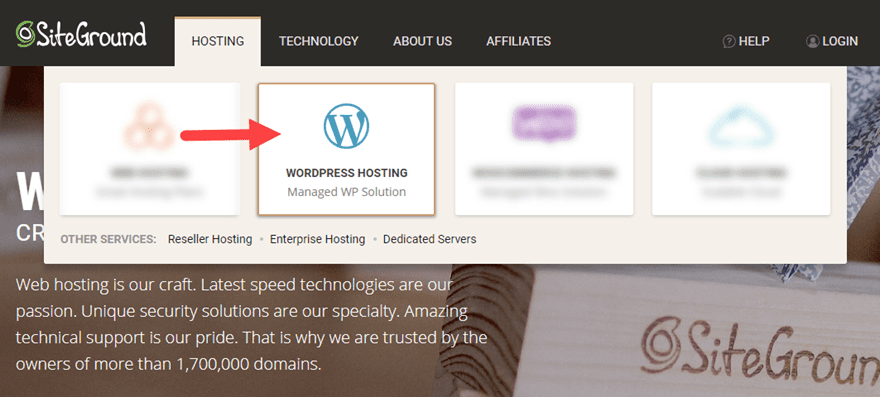
Because WordPress is such a popular CMS for websites, many hosting providers have managed hosting specifically for WordPress. In most cases, if opting for a WordPress Hosting plan, the process of installing WordPress is a simple click of a button. But, be warned, this may come with unexpected limitations. For example, WordPress hosting will not let you install any other CMS other than WordPress so if you want to change later on, you will have to change your hosting plan. There also may be limitations on what you have access to in your hosting account so it is a good idea to ask about this beforehand. In short, WordPress hosting makes things easier, but may also give you less control.
Some hosting providers (like WPEngine) are completely dedicated to hosting nothing but WordPress sites, so the process of installing WordPress is built in to the on-boarding procedure.
Some examples of Hosting Providers include but are not limited to:
- GoDaddy
- Flywheel
- Dreamhost
- Hostgator
- Siteground
- Cloudways – (read more about Cloudways for WordPress)
- BlueHost
- WPEngine
Feel free to take some time to choose the best option for your own WordPress hosting provider.
How to Install WordPress Using Automatic “One-Click” Installers
The second easiest way to install WordPress (other than a WordPress Hosting provider) would be to use a one-click installer. One-click installers are scripts that hosting providers include to make popular CMS platforms like WordPress easy to install. And like the name suggests, it reduces the installation process to “one click” (okay, actually it is a few clicks, but you can’t blame them for trying). Different hosting providers will provide different installer scripts that allow you to install WordPress in “one-click”. Some popular installers include:
Softaculous
Installatron (see partners)
QuickInstall (by MOJO Marketplace)
MOJO Marketplace
To see what installers you have available, you will need to login to Cpanel and check out what is included. Normally, you can find them under a category with the title “Autoinstallers” or “Software” or “Website”.
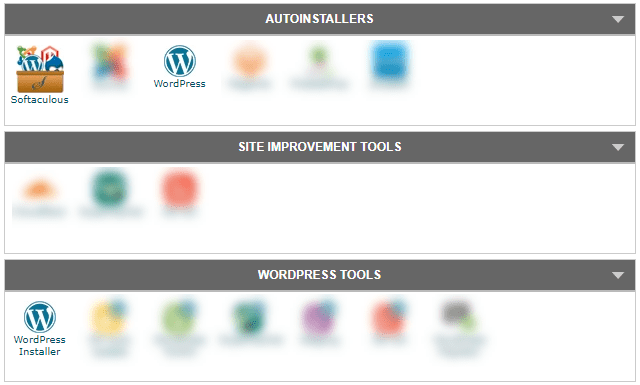
Siteground Cpanel offers WordPress installation via Softaculous

Godaddy Cpanel offers WordPress installer via Installatron
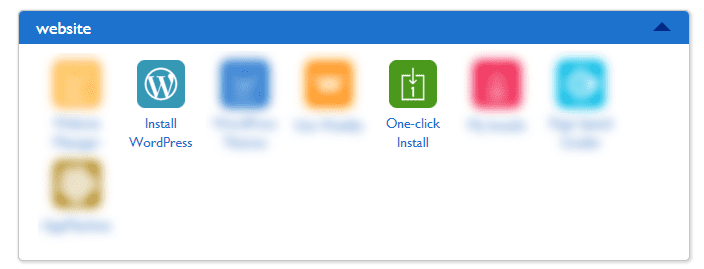
Bluehost Cpanel includes WordPress installer via QuickInstall
Note: If you see a script called “WordPress” or “WordPress Installer”, there really is no need to look any further. This is a convenient way to launch the wordpress script offered by a particular software (like Softaculous, Quickinstaller, etc…).
For this example, I’m going to show you how use Softaculous to install WordPress, but many of these installers will function the same way. First, select Softaculous from the Cpanel dashboard.

Then select the WordPress script from the list.
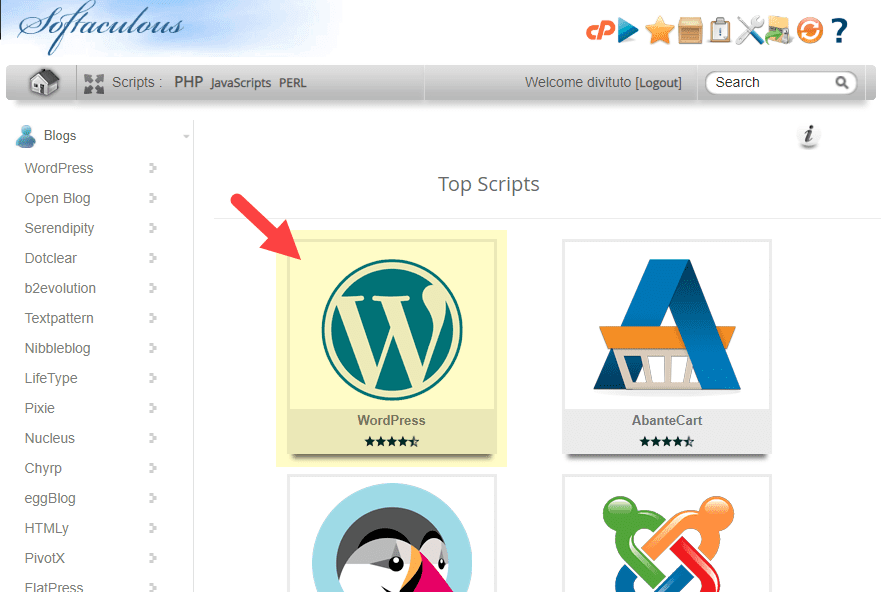
Then click install.
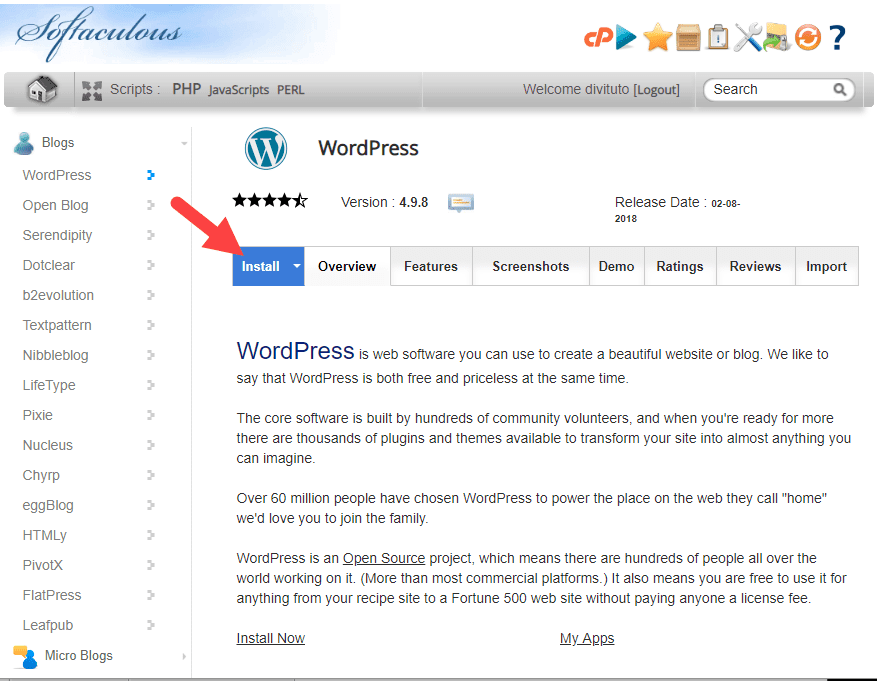
If you choose a quick install, you will need to enter the following:
- The domain for the install
- The directory location for the install (if you are installing to the root, you should be able to just leave option blank)
- The Admin Account information (username, password, email) for accessing the backend of the site.
Then Click Install.
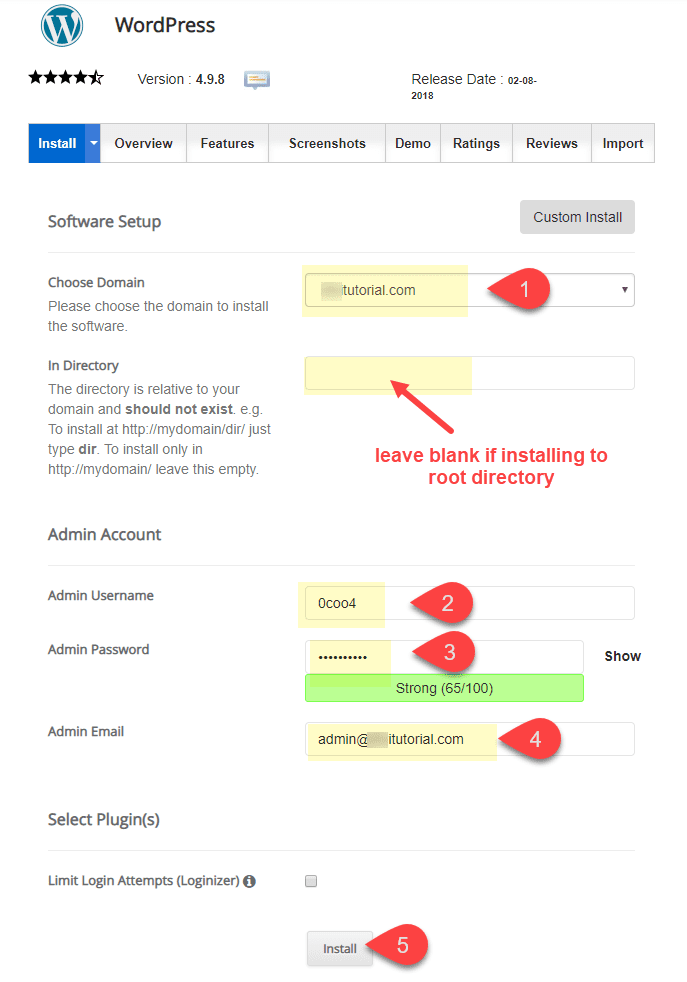
And that’s it! WordPress will be installed for you.
Once done, you can login to your site with the admin account info you entered by going to www.yoursite.com/wp-login.php from your browser.
How to Install WordPress Manually on any Web Host
At this point, you should have a web host and your domain set up and ready to go.
Step 1: Download the WordPress .zip File
First, go to wordpress.org and download the latest version of WordPress by clicking the Download WordPress button.
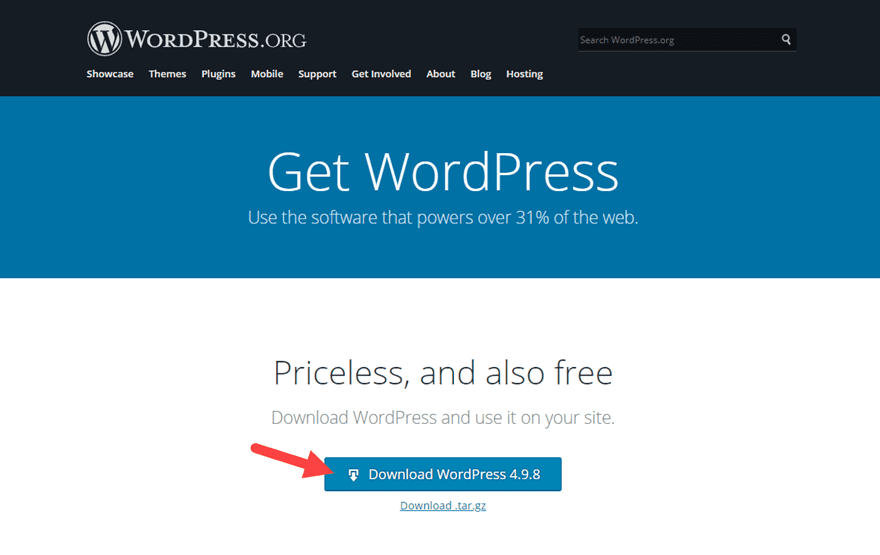
Once clicked the zip file will be downloaded to your computer (probably to your downloads folder). Go ahead and unzip (extract) the files so they will be ready.
Step 2: Create a Database and Database User
Before adding WordPress to your web server, you must first create a database to store those WordPress files. To do this, login to your hosting account and launch Cpanel.
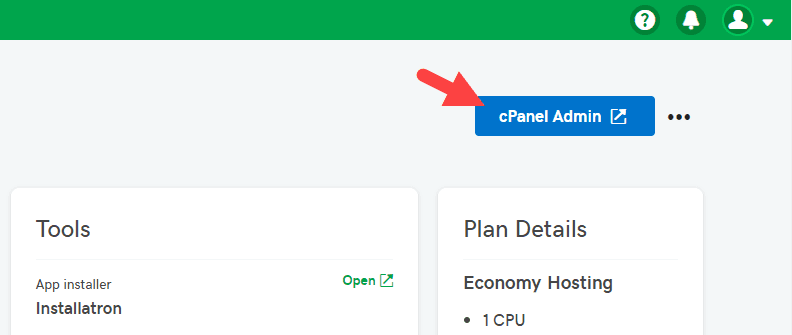
This process will look differently for each hosting provider. But if you get confused, you can always access cpanel directly by entering you domain followed by “:2082” in the address bar of your browser (i.e. www.yourwebsite.com:2082).
From the Cpanel dashboard, open MySQL Databases (it should be under the Databases category).
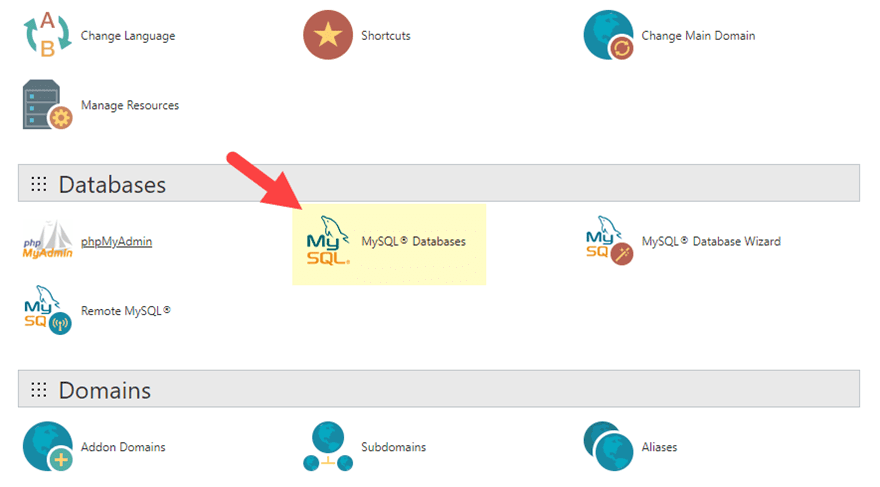
There you need to do 3 main things:
- Create a New Database
- Create a New User for you Database
- Add the User to the Database
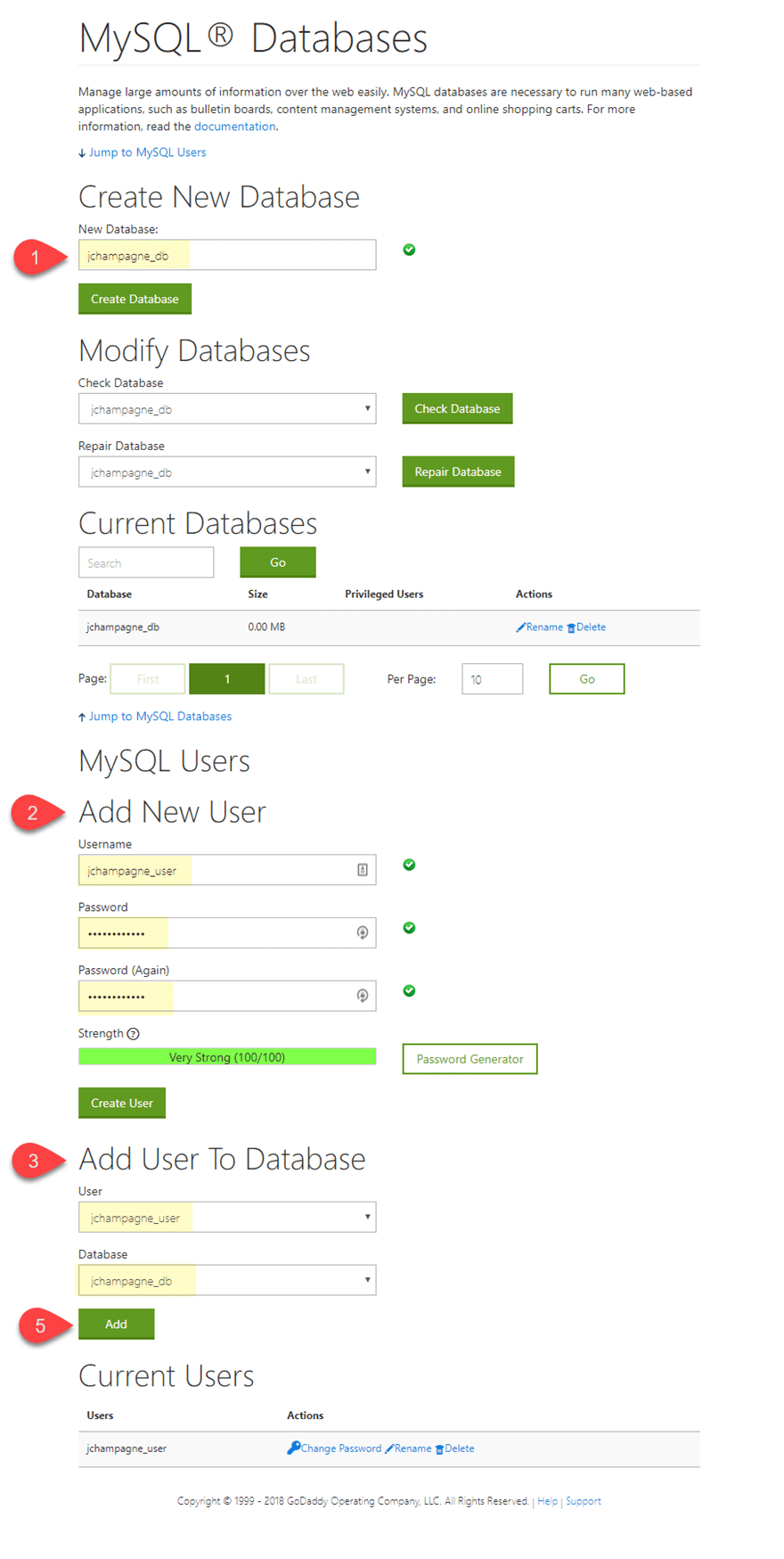
You will need to remember this information (database, username, password) when setting up your WordPress Installation you may need to save it somewhere temporarily.
Now you are ready to transfer your WordPress files over to your site.
Step 3: Upload WordPress Files to Your Site’s Root Folder
Accessing your site’s directory on your web server will require using an FTP client or accessing the directory using the file directory via CPanel.
Method 1: Uploading the Files with FTP (FileZilla)
To access your web server root directory using FTP, You will need an FTP client like (FileZilla, Cyberduck, or Transmit). Feel free to find the best FTP client for your needs. For this illustration, I’m using FileZilla.
Open FileZilla and enter the FTP credentials provided by your hosting provider. This includes the Hostname (the address to the server), Username, Password, and Port (leaving the port blank will work fine in most cases). In some cases you will need to create a new FTP user on your hosting site so that you will will have a username and password to login to the server.
FileZilla (like most FTP clients) will have a section on the left that accesses your local site (your computer) and a section on the right to access the remote site (your web server). On the left, locate and open the WordPress Folder contents you downloaded earlier. On the right, open the public_html directory (this is the root directory of your website).
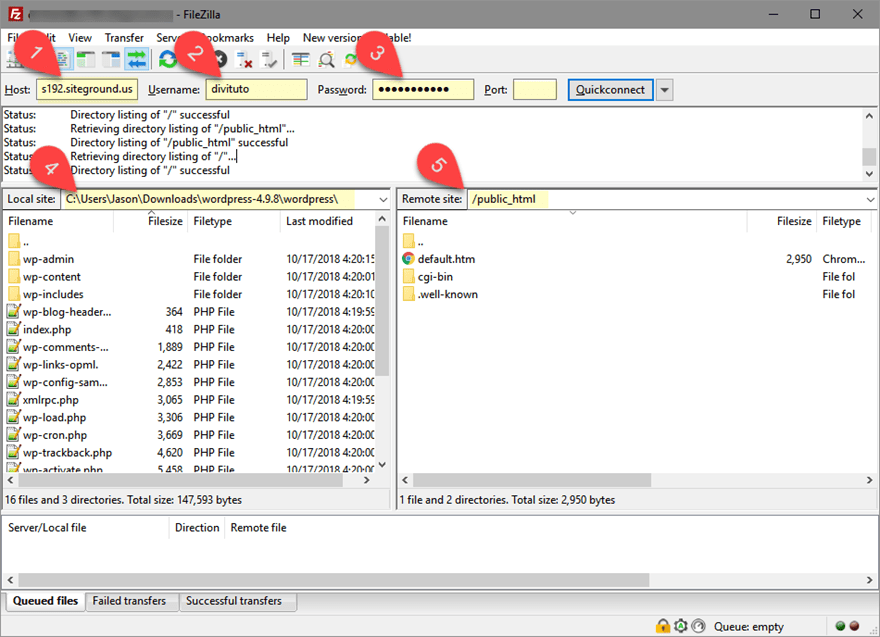
Select all the the wordpress files from the left and drag them over to the public_html directory on the right.
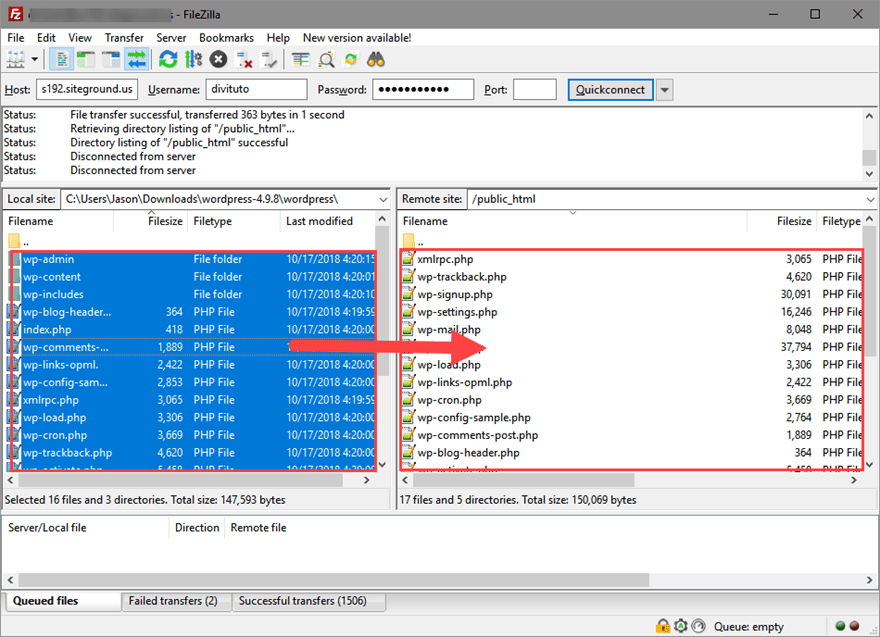
This may take a few minutes to complete. But after the transfer is complete, you are ready to run the WordPress installation.
For more info, you can check out our ultimate guide to managing your WordPress website with FTP.
Method 2: Uploading the Files using File Manager from Cpanel
As an alternative to using an FTP client, it may be easier to transfer your files using File Manager. Login to Cpanel and launch the File Manager (it should be under the Files category in the Cpanel dashboard).
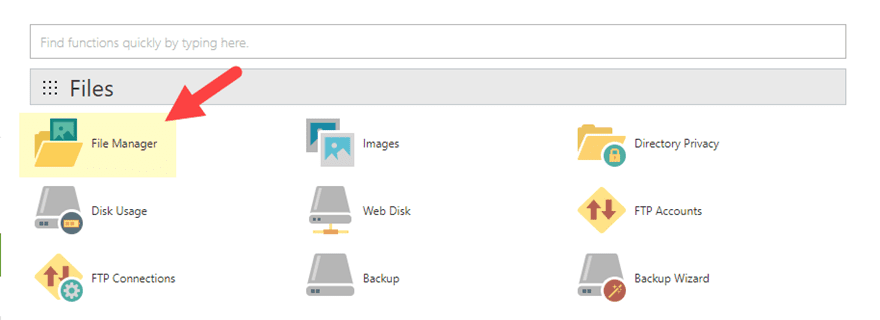
Once clicked, you may be prompted to choose the directory location. Most of the time this will be the Web Root (public_html/www). And if you have more than one website on the server, make sure you choose the one that needs the new WordPress install.
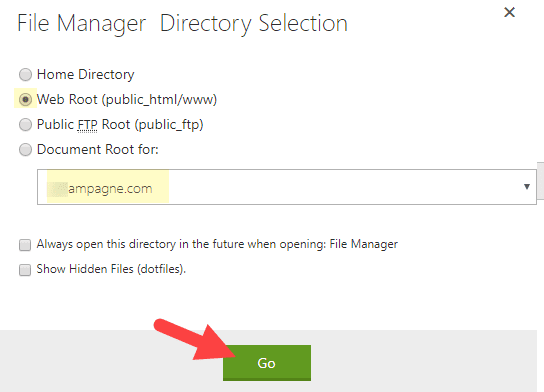
From the File Manager, make sure you are at the web root (public_html) directory and then click the upload button.
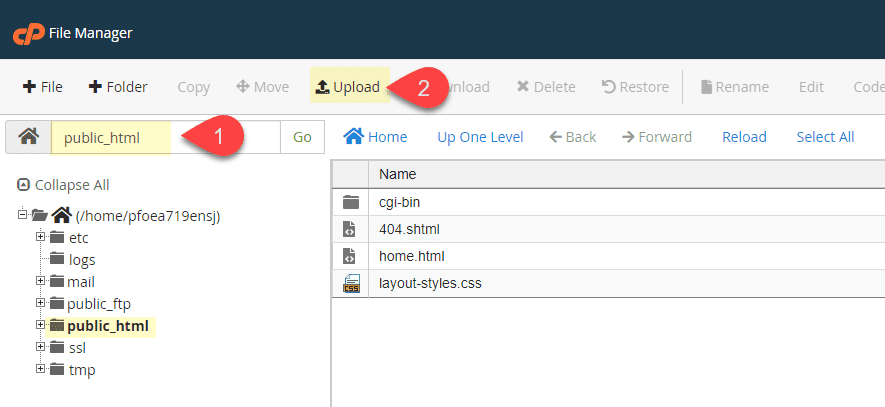
Then upload the WordPress Zip file.
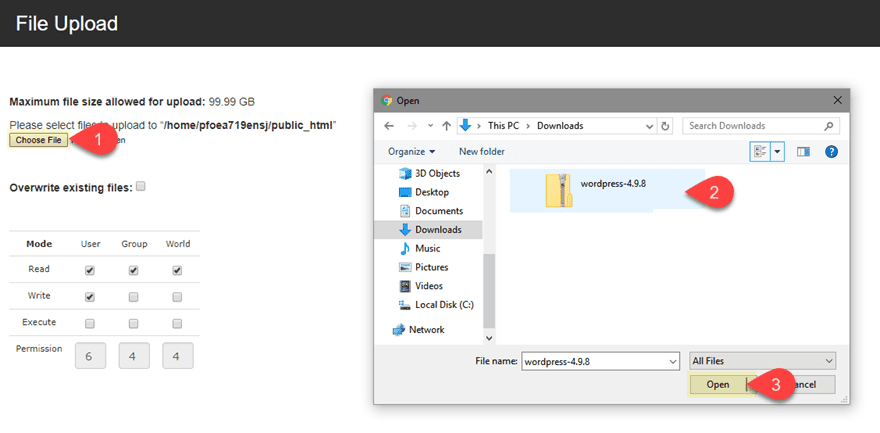
This would be a good time to take a few sips of coffee while you wait for the file to be uploaded.
Once done, you will need to extract the folder/files from the zip file.
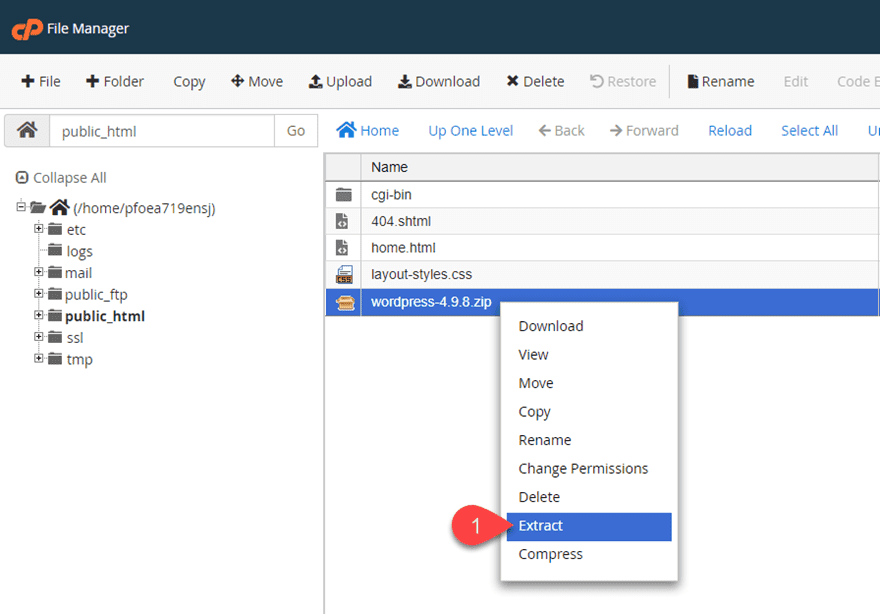
Once extracted, you will see that a new extracted folder appears at the root directory. We are not quite done yet. You see, technically, WordPress lives wherever the files live. Open the extracted folder to see the WordPress files.
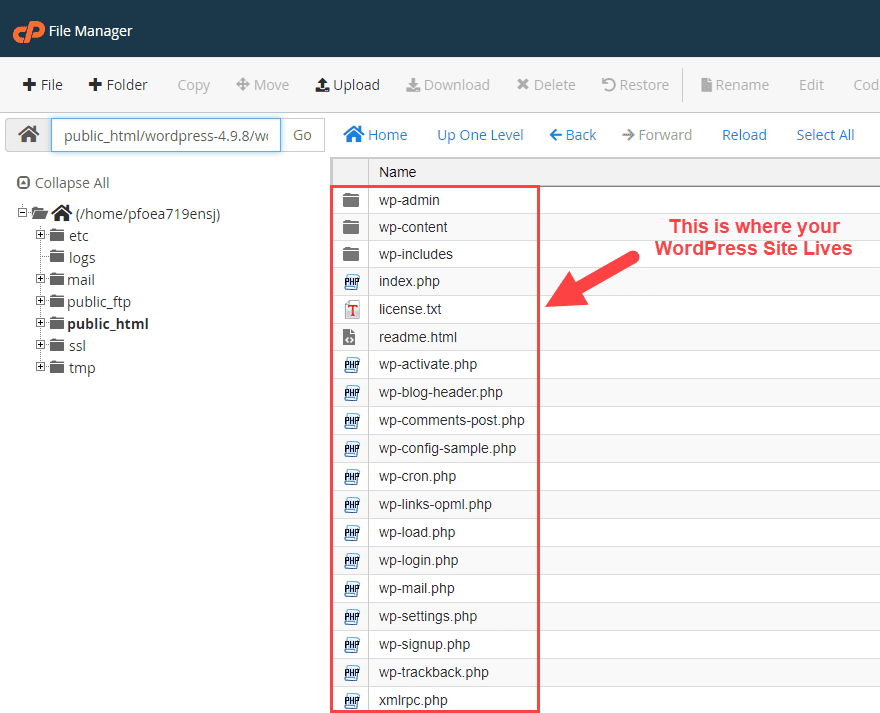
So if you want WordPress to live at the root directory (which is what you want most of the time), you need to move the files from its folder(s) so that all the files exist at the web root (public_html). To move the files, click select all to select all the WordPress Files and select to move them. Then select the directory you want to move the files to. In this case it is the public_html directory.
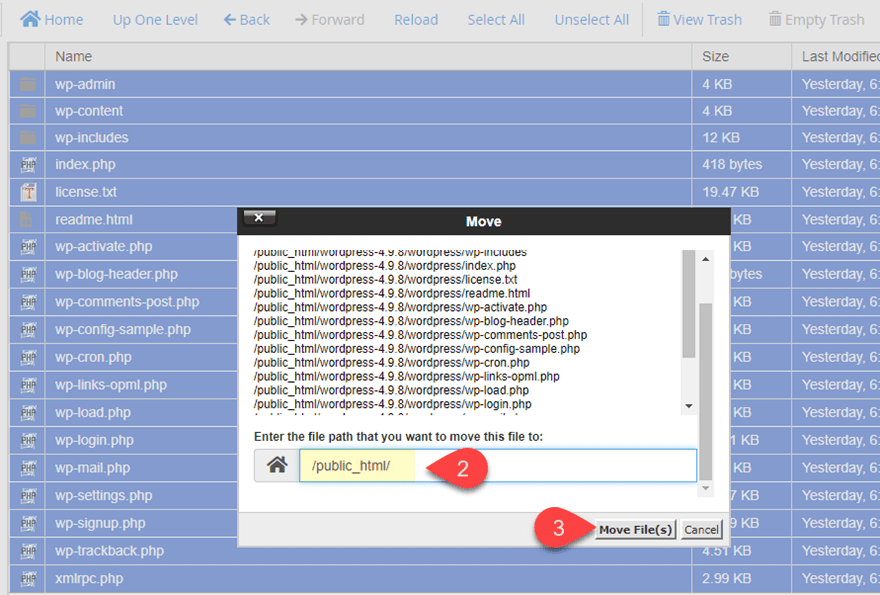
Now all of the files are at the intended directory.
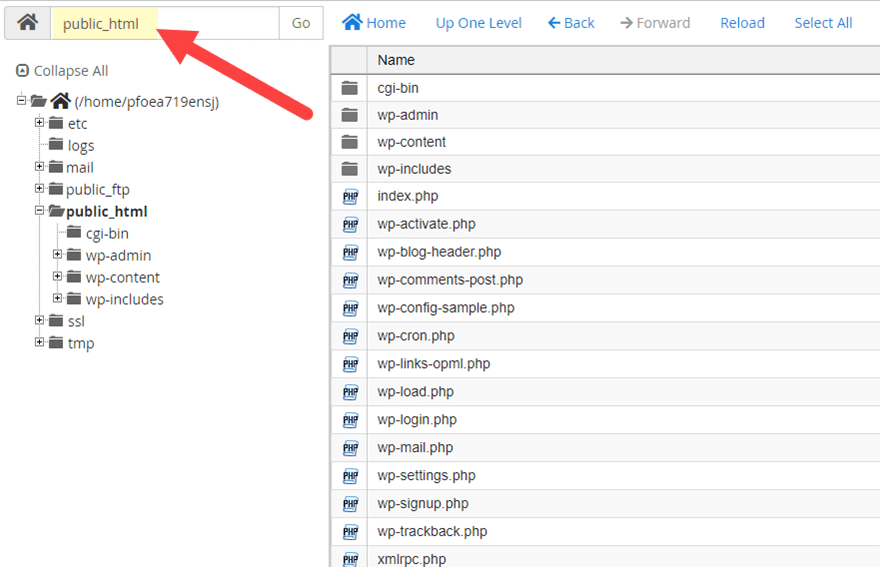
Right now your WordPress site is accessible from www.yoursite.com.
But if you wanted WordPress to exist in a subdomain, all you would need to do is create a new folder at the root (public_html) and move all the WordPress files into that sub folder. For example, if I created a new folder with the name “wpsite” and then moved the WordPress files into that folder, my WordPress site would now be accessible from www.yoursite.com/wpsite/ instead of www.yoursite.com.
Run the WordPress Installer
Now that you have the WordPress files loaded on your host server at the correct directory, it’s time to run the famous five-minute WordPress installation process. You may be thinking, “Install WordPress? Haven’t I already done that?!”. Don’t worry, you have done most of the heavy lifting already. This important installation process adds WordPress to your database.
To jumpstart the WordPress installer, simply navigate to your site from your web browser. So, if you have WordPress at the root, go to www.yoursite.com.
The first step allows you to select a language. Once you select your language, click continue.
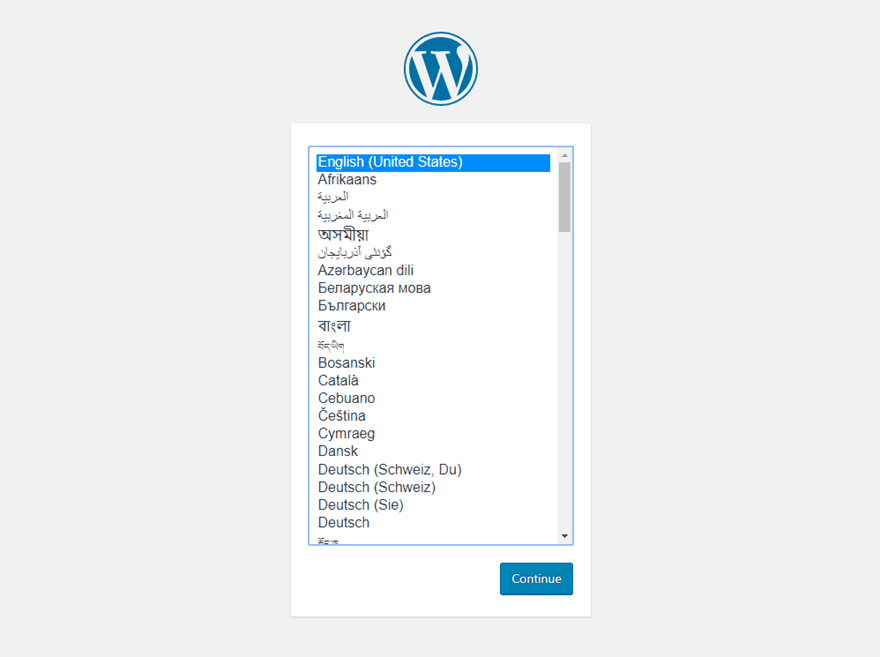
Next, you will be prompted to get your get your database credentials which were created in step 2 above.
When ready, click “Let’s Go”.
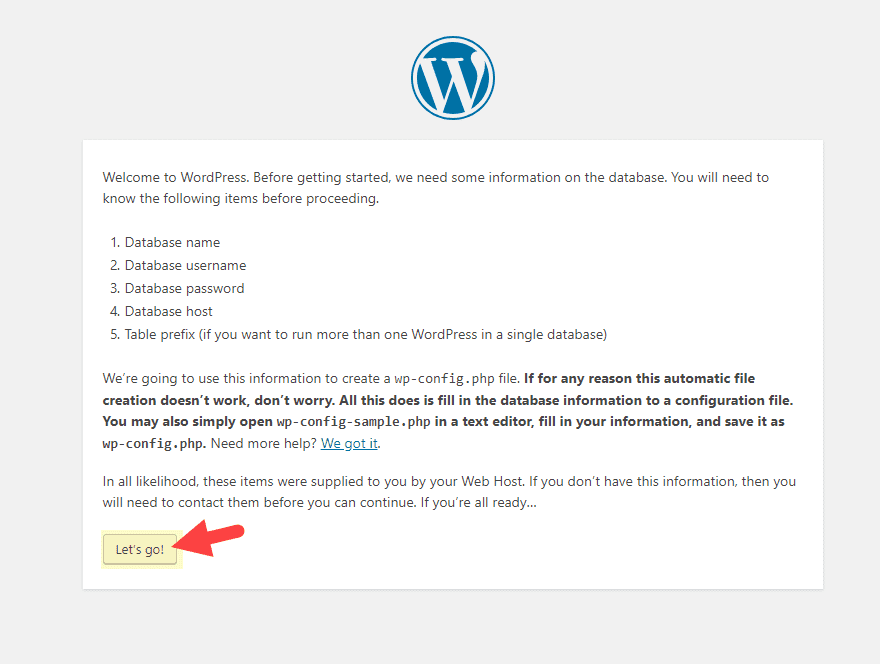
Enter the Database Name, Database User, and Database Password you created in step 2. You can leave the Database Host as “localhost” and the Table Prefix as “wp_” unless you have a unique setup in mind. Then click Submit.
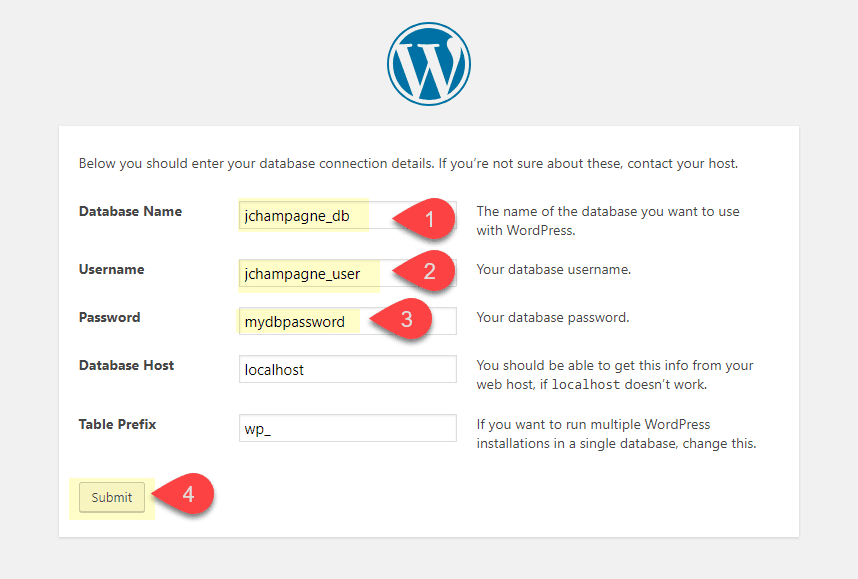
Now run the installation.
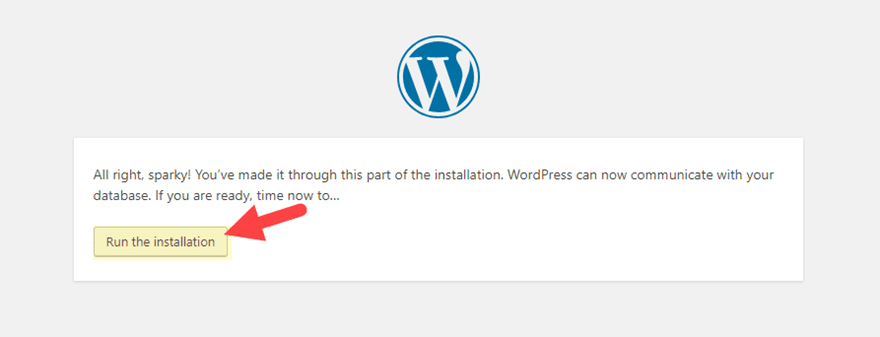
For this last step, enter the information needed for your new WordPress website. This includes the Site Title, the admin username and password to access the backend of your site, and the admin email address. Don’t worry, you can always change this later within the WordPress dashboard after WordPress is installed. Once done, click Submit.
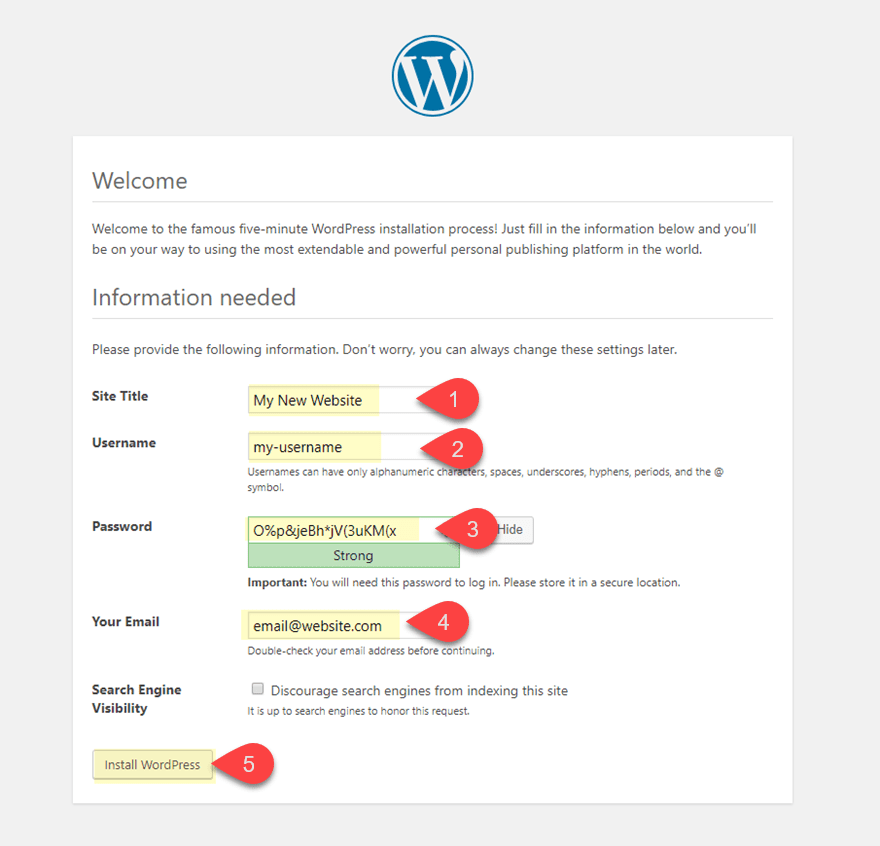
You will be greeted with a nice message telling you that the installation was a success! Click the Login button.
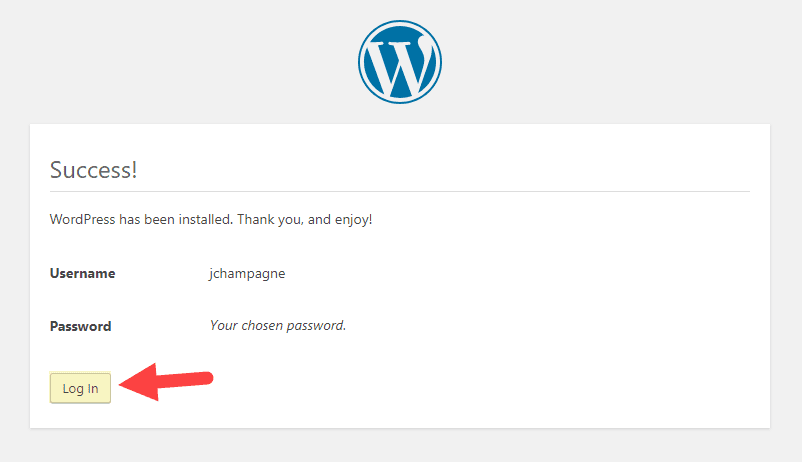
This will bring you to the login page to your WordPress website. You will want to bookmark this page for the future. It can also be accessed by going to the following URL:
www.yoursite.com/wp-login.php
Or if you don’t like that url, you can also go to www.yoursite.com/admin and it will redirect you to login as well.
To login, enter the admin username and password you created in the last step of the WordPress Installation process under “Site Information”.
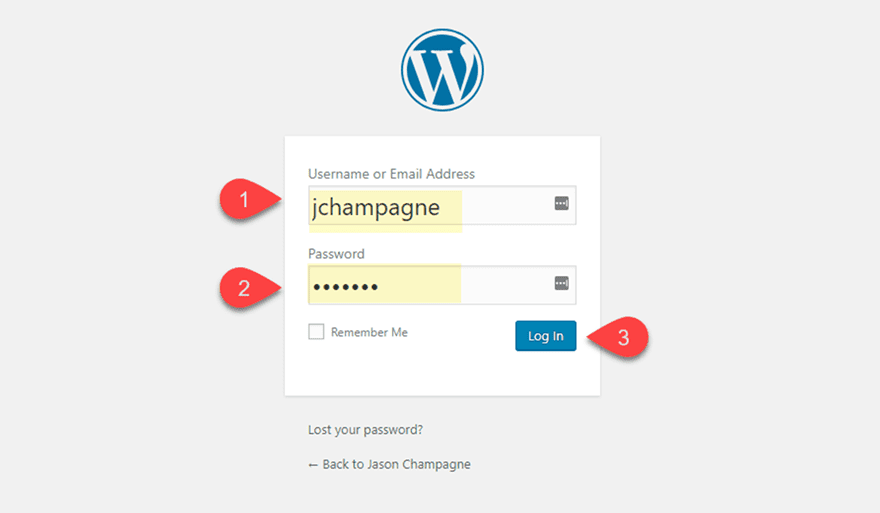
This will bring you to your WordPress Dashboard, the backend of your site.
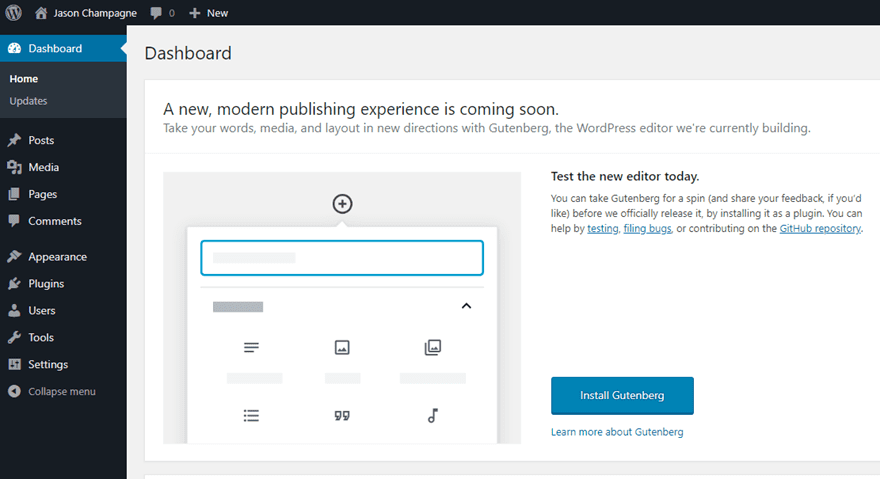
And if you haven’t checked already, visit your live site to see your brand new website! The default WordPress theme will be active.
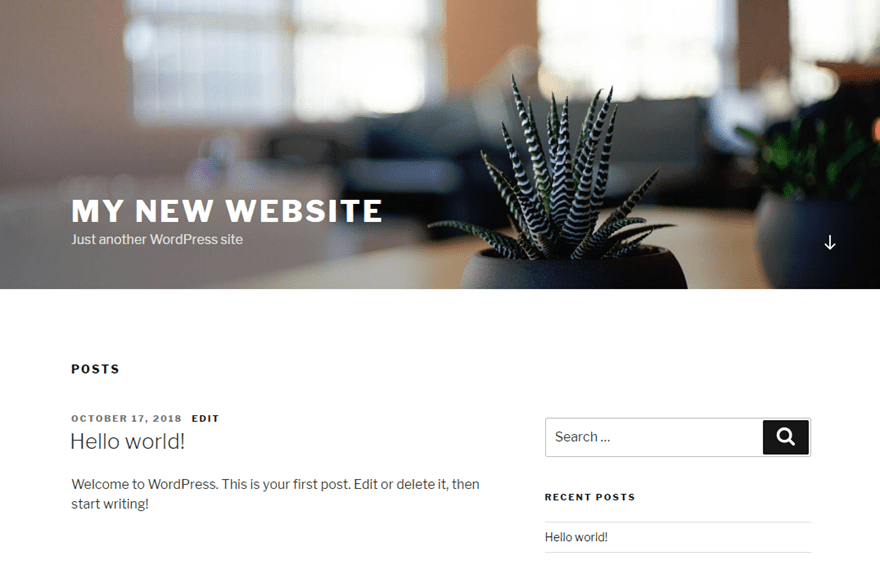
How to Install WordPress Locally on Your Computer
Installing WordPress on your personal computer can be a great way to speed up development of your WordPress website since you will not be dependant on the internet speed of your ISP. It is always helpful to have a separate local installation of your live site for testing purposes too. That way you can fix any bugs before pushing necessary updates to the live site.
If you are wanting to install WordPress on your personal computer, you will need to setup a local server. The two most popular environments for doing this are WAMP (for windows) and MAMP (for Mac).
Installing WordPress on Windows using WAMP
WAMP (a.k.a WampServer) is helpfully named to describe what it is: a Windows environment with an Apache web server, supporting PHP and a MySQL database. And it is a great local server for WordPress.
Installing WAMP on Your Computer
To install WAMP on your Windows PC, you need to go to their website and download the installer. Make sure you get the latest version (64bit or 32bit).
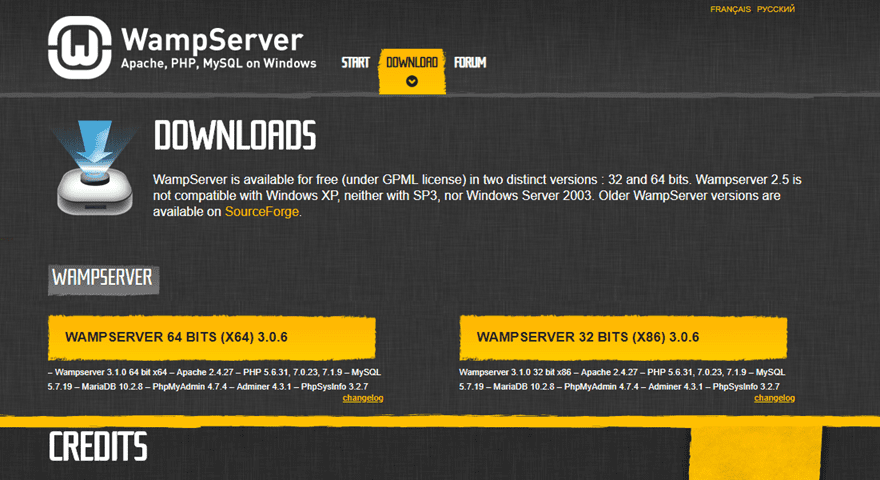
After it downloads, open the file to run the setup wizard to install Wampserver to your computer.
You may be prompted to select the default directory location for the install, your default browser, text editor, among other things. Once the setup wizard is done. Click finish.
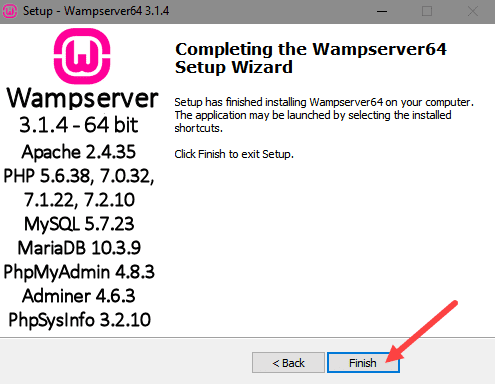
Now you can launch WampServer.
Then click the small green WampServer icon at the bottom of your desktop and go to phpMyAdmin.
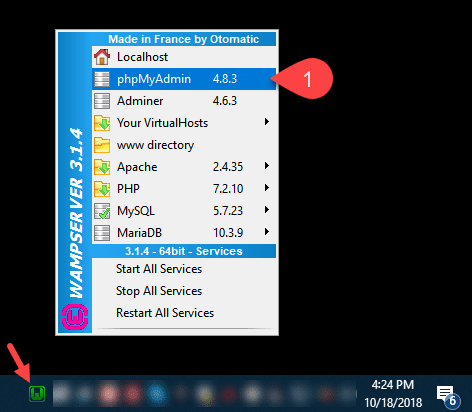
Now login to your phpMyAdmin by entering the username “root” and clicking the Go button (you can leave the password blank).
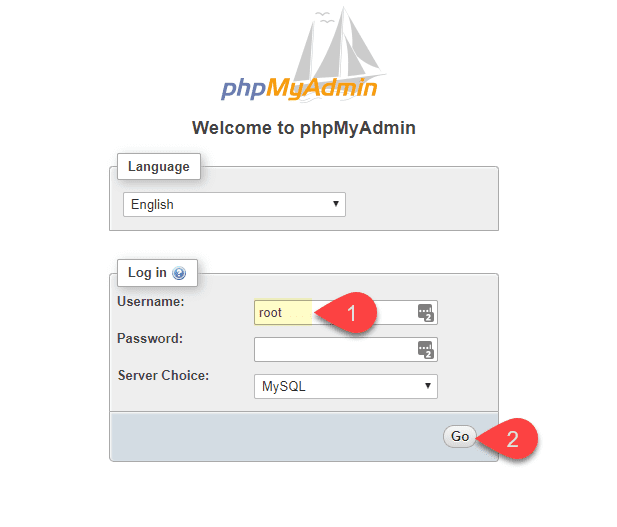
Click the Databases tab at the top of phpMyAdmin and create a new database by entering the Database Name and Collation. Then click the Create button.
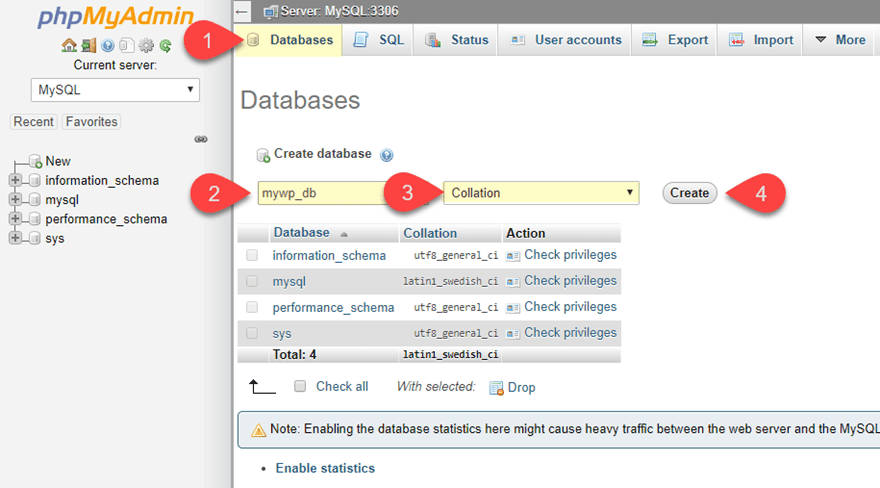
Installing WordPress on WampServer
Now that you have WampServer setup, you can now install WordPress on this local server. To do this, you will need to download the latest version of WordPress. Then unzip the WordPress zip file, and then drag the unzipped folder named “WordPress” over to the location where your WampServer is installed. Since I installed a 64 bit version as the default setting, this location will be at the following location on my computer:
C://wamp64/www
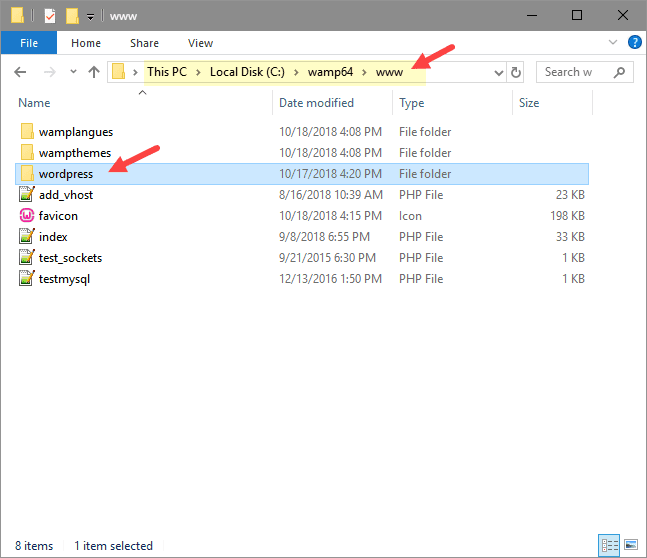
You can rename the WordPress folder to whatever you want for labeling future installs going forward.
Now open your browser window a go to:
https://localhost/wordpress
This will kickstart with WordPress Installation Process covered in detail above.
When prompted for your database info, enter the Database Name you created in phpMyAdmin. And enter the username “root”. You can leave the password blank. Then click Submit.
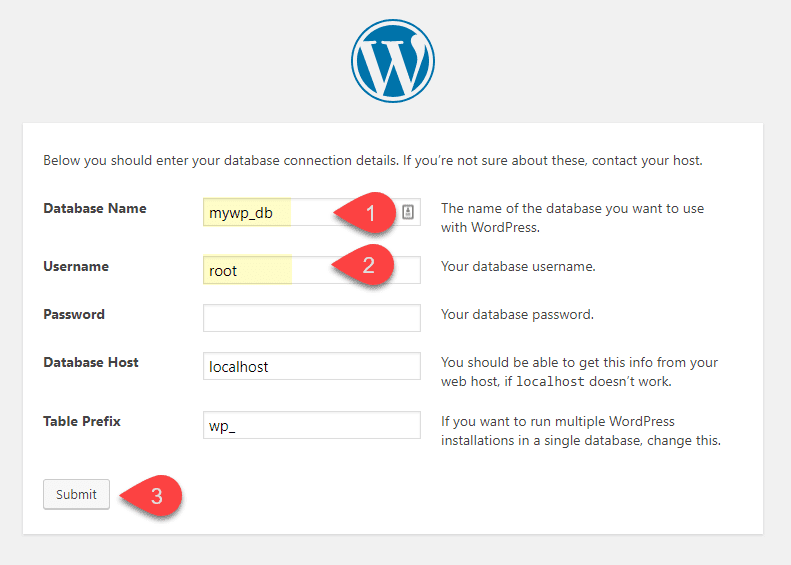
Then continue to run the installation and enter your site information.
Your new local WordPress site will be accessible from the following location moving forward:
https://localhost/wordpress
And, you can login to the site here:
https://localhost/wordpress/wp-login.php
For more on information, visit our more detailed post on installing WordPress on Windows..
Installing WordPress on a Mac using MAMP
MAMP (not to be confused with WAMP above), is also a free local server that you can use to host your WordPress website locally. Unlike WAMP (which is specific to Windows), MAMP can be installed on both Mac OS and Windows.
Installing MAMP on a Mac OS
To install MAMP on your Mac, first go to their website and download the latest version of MAMP for Mac OS.
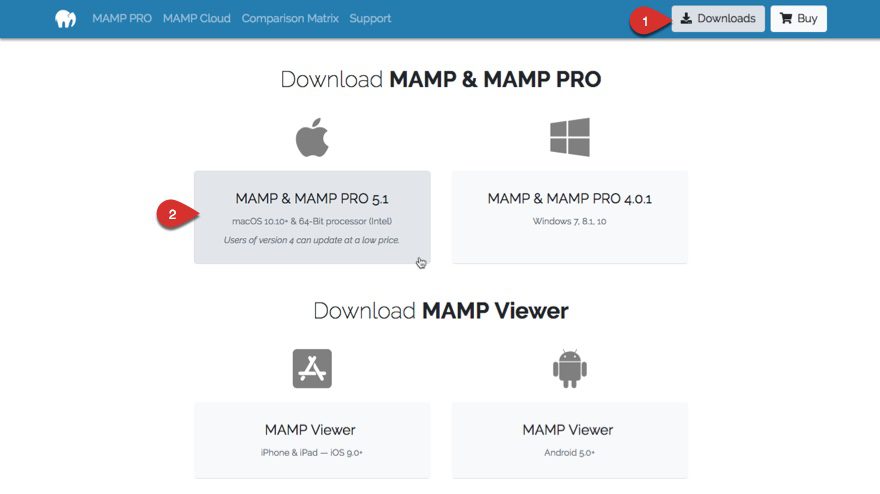
Open the downloaded file to launch the install. Click continue and complete all the steps to install the software.
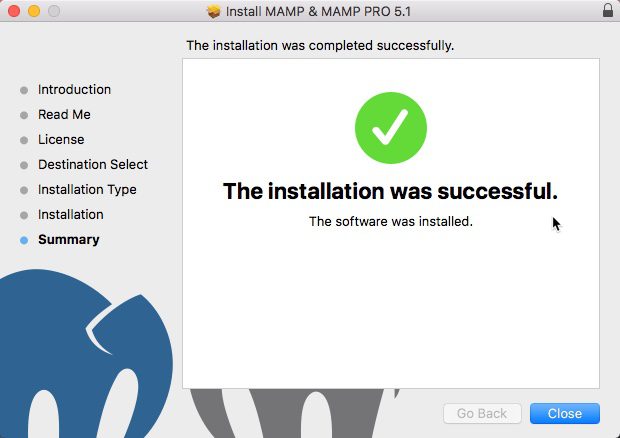
Next, launch the MAMP application. It should be located in your Applications folder or in Launchpad. There will also be a MAMP Pro version (which makes it easier to upgrade if needed) so make sure you launch the free version (with the gray icon).
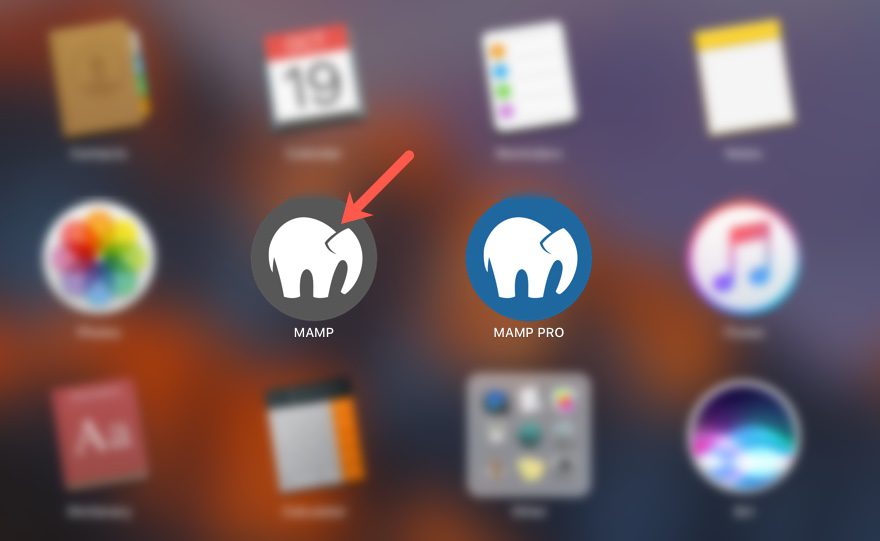
Next Click the “power” button on the right with the label “Start Servers”. After a moment, you should see a green light appear next to each of your servers (Apache and MySQL) listed in the upper right corner.
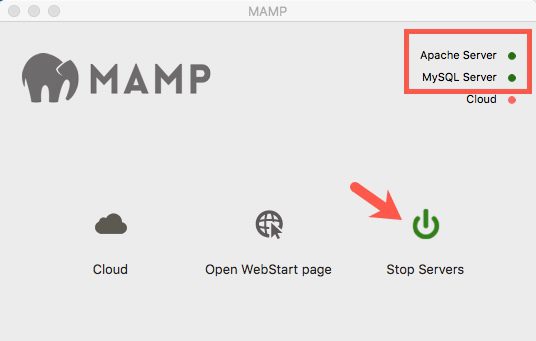
This should launch the WebStart page in your browser. But if not, you can click on it from the MAMP application window.
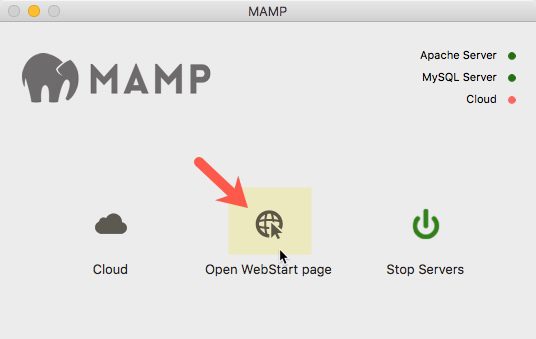
This page is actually hosted on your new MAMP local server at the following location:
https://localhost:8888/MAMP/
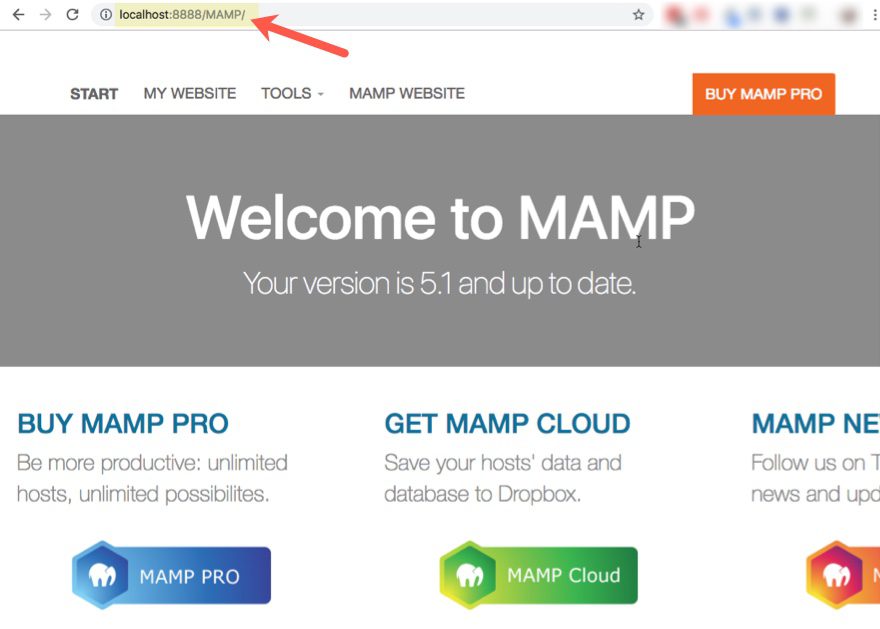
This page has helpful information about the server, but the main thing you need to do at this point is access phpMyAdmin to create a database before installing WordPress. Click on Tools in the navigation menu at the top of the page and select PHPMYADMIN from the list.
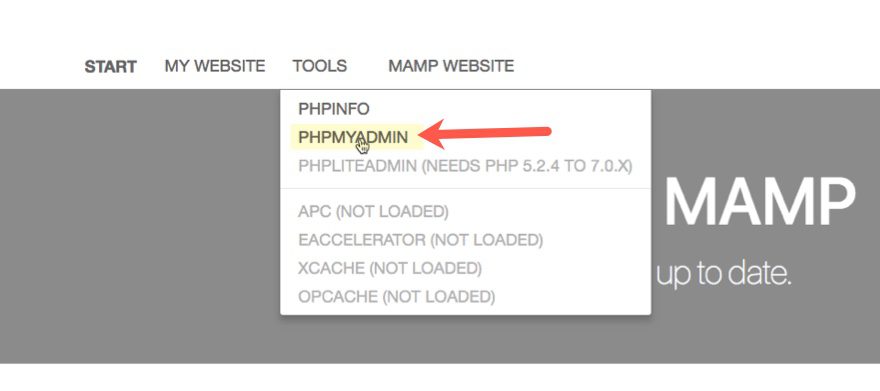
Or you can just go there directly using this url:
https://localhost:8888/phpMyAdmin/
Then select the Database tab at the top of the page and create a new database by entering a database name and clicking the create button.

Remember the database name because you will need it for the WordPress installation.
Installing WordPress on your MAMP server
Now that your MAMP server is up and running, you are ready to install WordPress. First, you will need to download the latest version of WordPress.

Next, you need to find the root folder for your local server. By default, the root folder has the name “htdocs” and can be found on your computer under Applications > MAMP > htdocs.
Now go find the WordPress download (probably in your downloads folder) and unzip it. Then drag the unzipped wordpress folder into the htdocs folder.
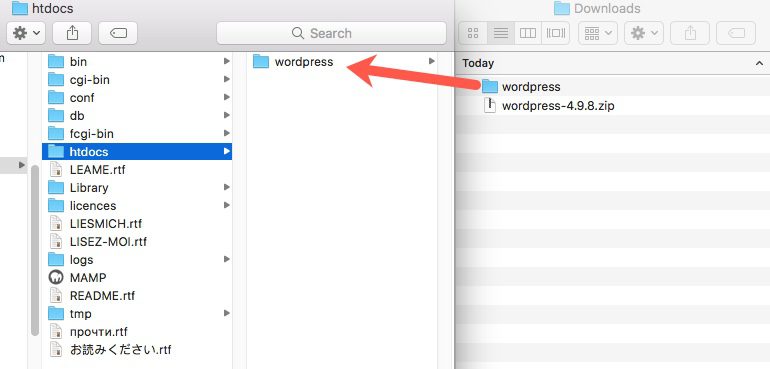
Keeping WordPress contained in the wordpress folder like this will allow your WordPress site to exist in a subdirectory at the following location:
https://localhost:8888/wordpress/
NOTE: You can rename the wordpress folder to whatever you want. This is helpful if you plan on adding more WordPress websites to the server.
Now all you need to do is go to the above URL (localhost:888/wordpress/) in your browser. This will start the WordPress Installation process.

Go ahead and select a language and on the next screen, click “Let’s Go” to enter the database details.
Enter the Database Name that you created in phpMyAdmin earlier. And enter “root” for the username and “root” again for the password.
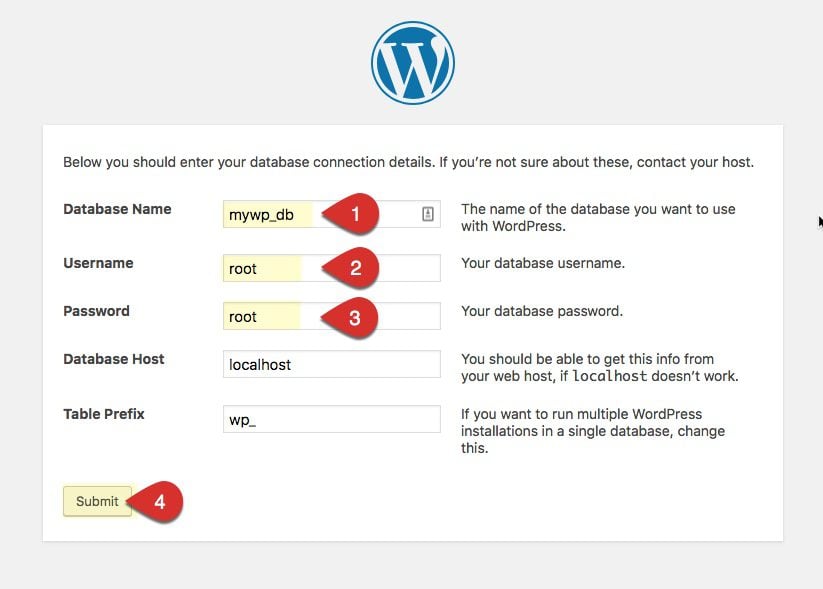
MAMP also provides database information for you in the WebStart page (localhost:8888/MAMP/) under the MySQL heading.
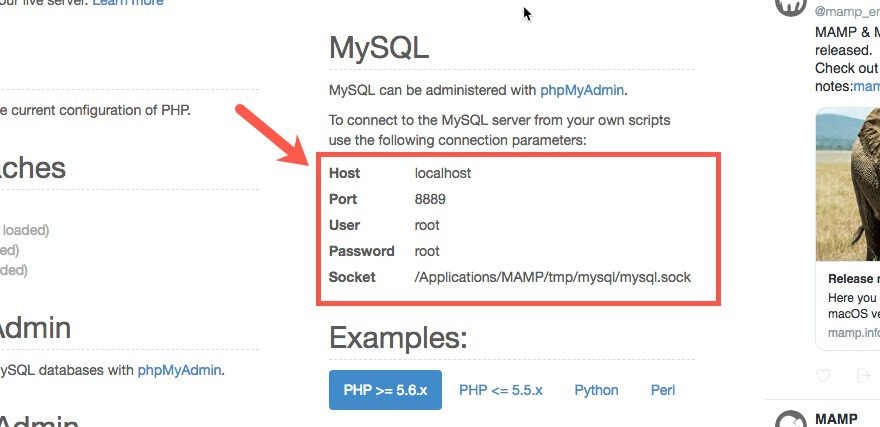
Then continue to run the installation and enter your site information.
Your new local WordPress site will be accessible from the following location moving forward:
https://localhost:8888/wordpress/
And, you can login to the backend of the site here:
https://localhost:8888/wordpress/wp-login.php
For more details, check our full article on how to create a local WordPress installation on a Mac.
Migrating Your Local WordPress Install to a Live Site
Now that you have a local installation of WordPress, you will probably want to migrate that installation to a live site someday. For more information on how to do this, check out or post on migrating your local WordPress installation to a live web server.
Installing WordPress in Your Language
Installing WordPress in a specific language is easy. In fact, a language option is the first thing that pops up when running the WordPress Installation process.

If you already have WordPress installed, you can also change the site language by going to your WordPress dashboard and navigating to Settings > General and updating the Site Language option.

Installing WordPress on a Virtually Private Server (VPS)
If you are looking beyond the typical shared hosting solution for your WordPress Website, you may benefit from a VPS. The main benefit of a VPS is that it gives your website a private server that you have more control over. We have a wonderful guide on how to install WordPress on a VPS using Cpanel and manually via SSH.
Installing WordPress on Google Cloud
Cloud hosting can be a beneficial alternative to hosting your WordPress site on a single server. These benefits include cost, uptime, speed, and scalability. If you are interested in cloud hosting for your WordPress site, check out our post on how to install WordPress on Google Cloud.
Next Steps: What to Do After Installing WordPress
Now that you have your new WordPress website up and running, take a few moments to glory in your success. You’ve earned it! After that, it’s time to think about next steps. One of the great things about WordPress is that it is open source and a ton of people support it, which means that it is improving every day. So there is always new things to learn. But where do you start? Here are a few suggestions.
Selecting a WordPress Theme
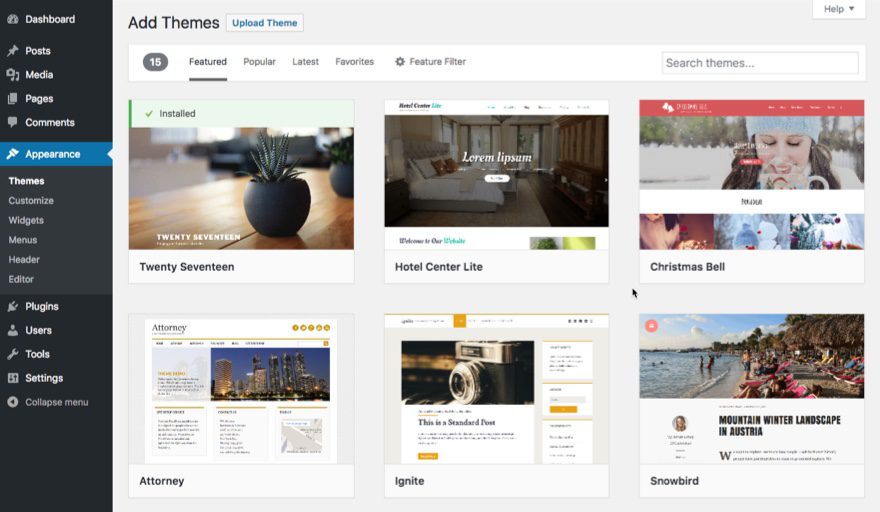
If you have a type of website in mind that you are wanting to design, starting with a WordPress theme can take a lot of the headache out of the design process, especially if you don’t know any code. A theme, in simple terms, is a skin for your website that styles all of your pages for you. Many of the WordPress themes are FREE and available from the WordPress Dashboard on your WordPress site. There are also many premium themes for sale across the web.
The Divi Theme by Elegant Themes is perhaps the most popular WordPress theme out there because it allows you to customize your website easily using a visual page builder. And it includes over 80 complete layout packs FREE with your membership.
Exploring WordPress Plugins
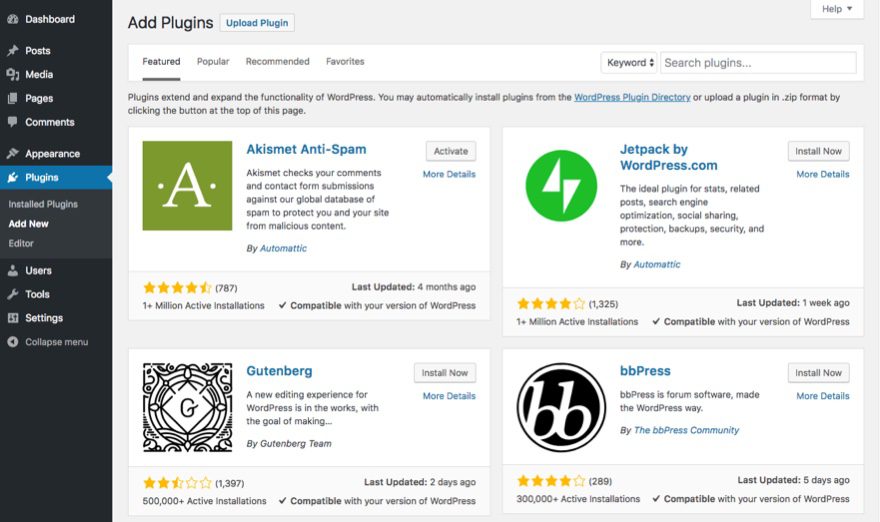
In addition to themes, WordPress comes with a huge selection of plugins that can add countless types of functionality to your site with having to hire a developer. You may be surprised at how much you can do with WordPress without knowing code. So, it is definitely worth exploring what is out there before you start getting your hands dirty. One of the first plugins you should look into getting is a credible plugin for backing up your WordPress website in case something breaks.
Learn More About WordPress
If you are like me and tend to jump into things without understanding them, you may run into a few walls as you try to understand your new WordPress website. If so, you don’t need to look very far for great resources on the web. To get you started, here are a few helpful resources from our blog.
For more info, check out the 10 Most Important Things You Should Do Immediately After Installing WordPress.
More Related Articles from our Blog
- How to install WordPress within a subdirectory
- How to Launch a WordPress Website in 8 Steps
- The Ultimate Guide to HTTPS and SSL for WordPress
- Converting HTML Sites to WordPress Sites
Final Thoughts
WordPress is an outstanding CMS for your website and, because of its popularity, the process of installing WordPress is quite easy in most cases. Whether you are new to WordPress or a seasoned WordPress developer, I hope this ultimate guide covers the steps needed to properly install WordPress according to your needs.
I look forward to hearing any suggestions or questions you may have in the comments below.
Cheers!
The post How to Install WordPress: The Definitive Guide appeared first on Elegant Themes Blog.
